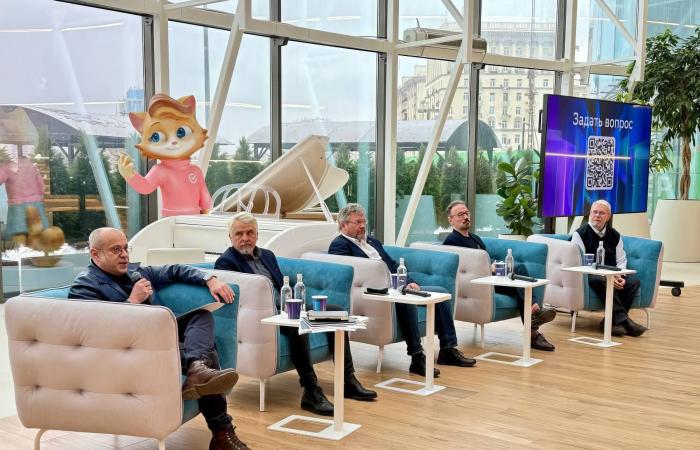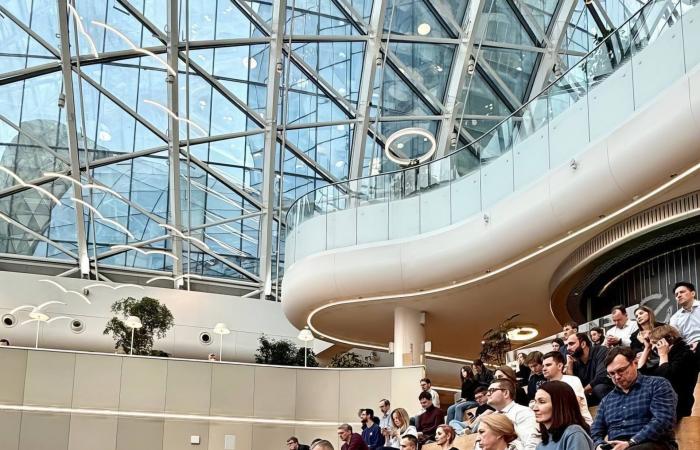
The five speakers. In the Alexandre Loutovinov center, on his right Nikolai Sevastyanov, on his left Yevgueny Kouznetsov. At the left end of the Albert Efimov image and at the right end, Sergei Peresleguine.
The Place de Russia in the space race, present and future: discussion for the day of cosmonautics.
Albert Efimov – Vice-president, director of research and innovation, moderator
Sergueï Peresleguine – Science fiction researcher and theorist
Nikolaï Sevastyanov – Designer of space systems, author and host of the program “Day of cosmonautics” on the trk “zvezda”
Evgeny Kouznetsov – Innovation expert, futureologist
Alexandre Loutovinov – Astrophysicist, doctor of physical and mathematics sciences
Here are the main ideas of the discussion.
1. Current condition of Russian cosmonautics
Russian cosmonautics maintains strong positions in many areas. Among them are scientific projects such as the SPEKTR-RG X-ray observatory and expertise in the energy field.
In inhabited programs, Russia is based on its historic leadership, even if the technologies used are obsolete.
In the field of rocket technology, work is underway on the Soyuz-5 launcher as an alternative to the reusable SPACEX systems.
The main weaknesses are the delay in commercial launches (third place after the United States and China), bureaucratization, lack of private investment and limited international cooperation opportunities.
2. Challenges
The industry must go to modern technologies: reusable rockets, ion engines, digital control systems and satellite constellations in low orbit.
The infrastructure based on geostationary satellites becomes obsolete.
Economic challenges include a low presence in commercial segments – communications, navigation, remote sensing data.
The space economy could exceed 1.5 billion of dollars by 2035, but Russia is underrepresented in these areas. There are no complete programs to support startups and business financing.
At the geopolitical level, the situation is complicated by sanctions and the rupture of cooperation with Western countries, limiting access to equipment, technologies and common projects. An example is the suspension of the Exomars mission and the stopping of German equipment on Spektr-RG.
3. Strategic opportunities
The Moon remains a priority as a test field for technologies, attractive as a source of titanium and launch point for expeditions to Mars.
The study of satellites of Jupiter and Venus and the development of autonomous systems with artificial intelligence to function under conditions of communication delays remain promising.
Support for the private sector and the creation of infrastructure for start -ups, as well as the development of Duales technologies – the transfer of space developments to metallurgy – are of great importance.
It is precisely the “deep” space exploration programs that can constitute a qualitative jump.
4. Recommendations
It is necessary to formulate a long -term vision (at least 100 years) in the field of space development.
If commercial actors can ensure development in the “nearby” space, then the state must set more ambitious objectives.
The return on investment in space is difficult to estimate, but it is worth trying. We must popularize space more actively and support young specialists.
The presence of clear and ambitious objectives (a return to space as a national idea) will attract talents to the space sector.
Internationally, international scientific and financial cooperation should be developed, but it should not be forgotten that truly significant programs will be implemented “alone”. Artificial intelligence in space is not science fiction, but a necessity (autonomous stations, data processing, etc.)
Source and photographic credits: Innovation & Research

The room during the discussion.










